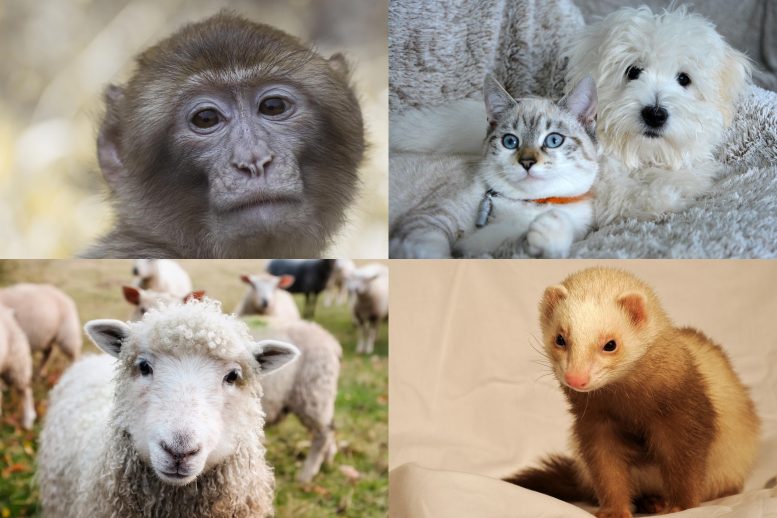
Numerous animals may be vulnerable to SARS-CoV-2, the virus that causes COVID-19, according to a large study modeling how the virus might infect different animals’ cells.
The study reports evidence that 26 animals regularly in contact with people may be susceptible to infection. Led by University College London (UCL) researchers, the research paper was published today (October 5) in the journal Scientific Reports.
The researchers investigated how the spike protein from SARS-CoV-2, the virus that causes COVID-19, could interact with the ACE2 protein it attaches to when it infects people.
The focus of the investigation was whether mutations in the ACE2 protein in 215 different animals, that make it different from the human version, would reduce the stability of the binding complex between the virus protein and host protein. Binding to the protein enables the virus to gain entry into host cells; while it is possible the virus might be able to infect animals via another pathway, it is unlikely based on current evidence that the virus could infect an animal if it cannot form a stable binding complex with ACE2.
The researchers found that for some animals, such as sheep and great apes (chimpanzee, gorilla, orangutan, and bonobo, many of which are endangered in the wild), the proteins would be able to bind together just as strongly as they do when the virus infects people. Some of the animals, such as sheep, have not yet been studied with infection tests, so this does not confirm that the animal can indeed be infected.
Lead author Professor Christine Orengo (UCL Structural & Molecular Biology) said: “We wanted to look beyond just the animals that had been studied experimentally, to see which animals might be at risk of infection, and would warrant further investigation and possible monitoring.
“The animals we identified may be at risk of outbreaks that could threaten endangered species or harm the livelihoods of farmers. The animals might also act as reservoirs of the virus, with the potential to re-infect humans later on, as has been documented on mink farms.”
The research team also performed more detailed structural analyses for certain animals, to gain a better understanding of how infection risks may differ across animal species. By comparing their findings to other experimental data, they set thresholds to predict which animals are at risk of infection, and which ones most likely cannot be infected.
They found that most birds, fish, and reptiles do not appear to be at risk of infection, but the majority of the mammals they reviewed could potentially be infected.
Professor Orengo added: “The details of host infection and severity of response are more complex than just the interactions of the spike protein with ACE2, so our research is continuing to explore interactions involving other host virus proteins.”
The team’s findings mostly agree with experiments conducted in living animals and with reported cases of infections. They predict possible infection in domestic cats, dogs, mink, lions, and tigers, all of which have had reported cases, as well as ferrets and macaques, which have been infected in laboratory studies.
First author, Su Datt Lam (UCL Structural & Molecular Biology and the National University of Malaysia) said: “Unlike laboratory-based experiments, the computational analyses we devised can be run automatically and rapidly. Therefore, these methods could be applied easily to future virus outbreaks that, unfortunately, are becoming more common due to human encroachment into natural habitats.”
Co-author Professor Joanne Santini (UCL Structural & Molecular Biology) said: “To protect animals, as well as to protect ourselves from the risk of one day catching COVID-19 from an infected animal, we need large-scale surveillance of animals, particularly pets and farm animals, to catch cases or clusters early on while they’re still manageable.
“It may also be important to employ hygiene measures when dealing with animals, similar to the behaviors we’ve all been learning this year to reduce transmission, and for infected people to isolate from animals as well as from other people.”
Reference: “SARS-CoV-2 spike protein predicted to form complexes with host receptor protein orthologues from a broad range of mammals” by S. D. Lam, N. Bordin, V. P. Waman, H. M. Scholes, P. Ashford, N. Sen, L. van Dorp, C. Rauer, N. L. Dawson, C. S. M. Pang, M. Abbasian, I. Sillitoe, S. J. L. Edwards, F. Fraternali, J. G. Lees, J. M. Santini and C. A. Orengo, 5 October 2020, Scientific Reports.
DOI: 10.1038/s41598-020-71936-5
The study was conducted by researchers in UCL Biosciences, UCL Science & Technology Studies, National University of Malaysia, King’s College London, and Oxford Brookes University, and was supported by Wellcome, the Newton Fund UK-China NSFC initiative, BBSRC, EDCTP PANDORA-ID NET, NIHR UCLH/UCL Biomedical Research Centre, and the Medical Research Council.
2 Comments
I hate animals and it wasn’t so interesting at all .I want some pictures about Chinese Martial arts not those things .I want news from China .
Then why did you read the article? If you want some pictures of Chinese Martial Arts, look it up! If you want news from China, got to a Chinese news website! If you hate animals so much and didn’t want to read anything anything about this topic, then why read the article! Stop complaining, you are not helping anybody, not the writers or the website by writing this stupid comment.